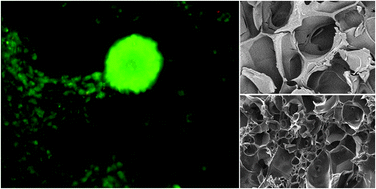One-pot synthesis of superabsorbent hybrid hydrogels based on methacrylamide gelatin and polyacrylamide. Effortless control of hydrogel properties through composition design
Abstract
Biocompatible methacrylamide-modified gelatin (GELMA) hydrogels with tuned characteristics, obtained through network-forming photopolymerization, have recently attracted increasing attention due to their wide range of possible applications such as drug release, tissue regeneration and generation of bioartificial implants. Due to the controlled number of C![[double bond, length as m-dash]](https://www.rsc.org/images/entities/char_e001.gif) C bonds, GELMA may simultaneously act as macromonomer and crosslinker leading through polymerization to hydrogels with rationally designed performances. This study provides effortless one-pot synthesis of hybrid hydrogels based on covalently linked GELMA and polyacrylamide (PAA), using photo-induced network-forming polymerization. Conventional synthesis of similar hydrogels leads to interpenetrating gelatin and PAA networks, usually involving multistep crosslinking of the components and the use of toxic crosslinkers. Through the described one-pot chemistry, the synthetic water superabsorbent PAA with its well-recognized advantages can rationally benefit from the high biocompatibility and cell-adherence of GELMA in a simple covalent way. This work provides a correlation between the composition and the corresponding hydrogel properties (including swelling, pH influence, mechanical behaviour, ability to generate porous scaffolds, enzymatic degradation). The addition of PAA modulated the network density and the water affinity allowing the control of elasticity and degradability. Supplementary crosslinking of the synthetic component provided additional control over hydrophilicity. The capacity of such hydrogels to generate porous scaffolds was proved; interesting morphologies were developed only by varying the composition. In vitro cellular studies indicated that the presence of GELMA conferred controlled cell-affinity properties to the bicomponent hydrogels. Nevertheless, the drug release potential of such hydrogels was preliminarily investigated using sodium nafcillin. GELMA–PAA hydrogels may be useful for tissue regeneration due to effortless synthesis, compositional flexibility and variable properties.
C bonds, GELMA may simultaneously act as macromonomer and crosslinker leading through polymerization to hydrogels with rationally designed performances. This study provides effortless one-pot synthesis of hybrid hydrogels based on covalently linked GELMA and polyacrylamide (PAA), using photo-induced network-forming polymerization. Conventional synthesis of similar hydrogels leads to interpenetrating gelatin and PAA networks, usually involving multistep crosslinking of the components and the use of toxic crosslinkers. Through the described one-pot chemistry, the synthetic water superabsorbent PAA with its well-recognized advantages can rationally benefit from the high biocompatibility and cell-adherence of GELMA in a simple covalent way. This work provides a correlation between the composition and the corresponding hydrogel properties (including swelling, pH influence, mechanical behaviour, ability to generate porous scaffolds, enzymatic degradation). The addition of PAA modulated the network density and the water affinity allowing the control of elasticity and degradability. Supplementary crosslinking of the synthetic component provided additional control over hydrophilicity. The capacity of such hydrogels to generate porous scaffolds was proved; interesting morphologies were developed only by varying the composition. In vitro cellular studies indicated that the presence of GELMA conferred controlled cell-affinity properties to the bicomponent hydrogels. Nevertheless, the drug release potential of such hydrogels was preliminarily investigated using sodium nafcillin. GELMA–PAA hydrogels may be useful for tissue regeneration due to effortless synthesis, compositional flexibility and variable properties.


 Please wait while we load your content...
Please wait while we load your content...